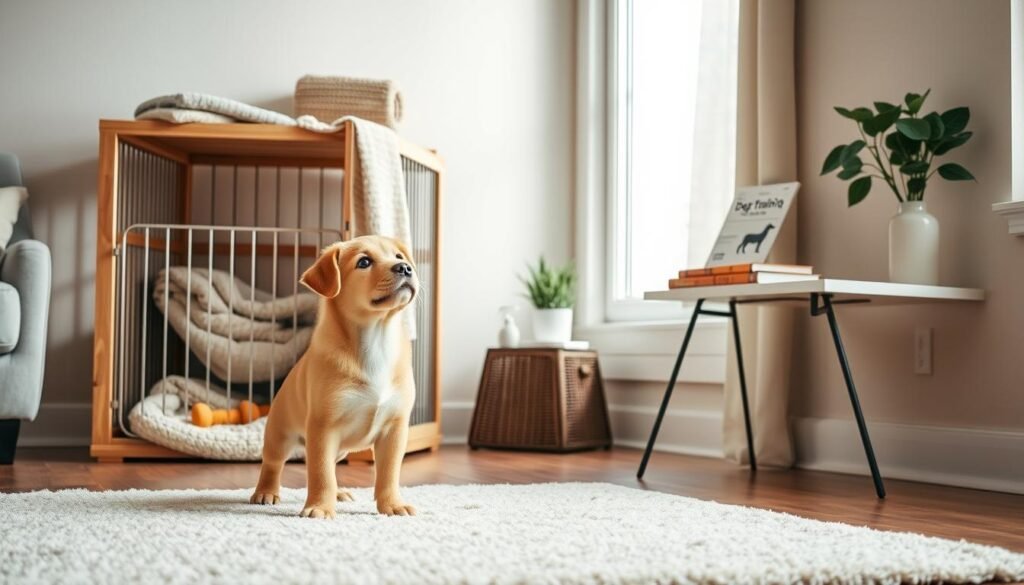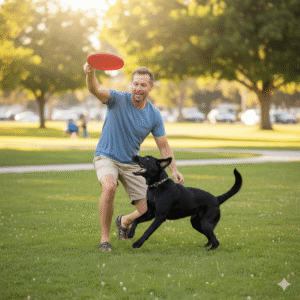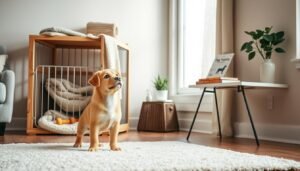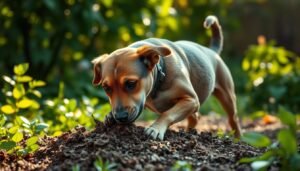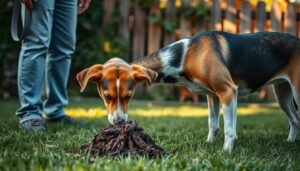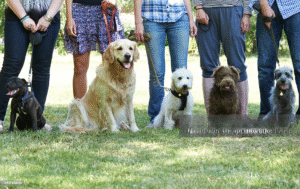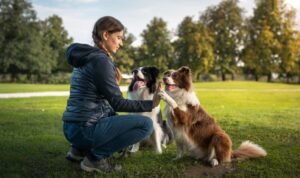Dealing with a dog that pees in the house can be frustrating and stressful. As a dog owner, I’ve experienced this issue firsthand. I understand the importance of addressing it promptly.
Housebreaking is a crucial aspect of dog ownership. It’s essential to identify the underlying causes of accidents in the house. Whether it’s due to medical issues, lack of training, or anxiety, there are effective strategies to overcome this problem.
In this article, I’ll share practical housebreaking tips and techniques. These will help you stop your dog from peeing in the house. By following these steps, you can strengthen your bond with your dog. You’ll also create a more harmonious living environment.
Key Takeaways
- Identify underlying medical issues that may be causing accidents
- Establish a consistent housebreaking routine
- Use positive reinforcement training techniques
- Watch for signs of anxiety or stress that may lead to peeing
- Clean up accidents properly to prevent re-marking
Understanding the Reasons for Indoor Peeing
Dogs peeing indoors is frustrating and often a sign of a bigger problem. To stop this, it’s important to know why it happens.
Common Causes of Indoor Accidents
There are many reasons for indoor accidents. These include medical issues, not enough training, and changes in the environment. For example, health problems like urinary tract infections can make dogs pee more often.
| Medical Condition | Symptoms |
|---|---|
| Urinary Tract Infection | Frequent urination, accidents in the house |
| Kidney Stones | Pain while urinating, accidents |
| Diabetes | Increased thirst and urination |
Signs of a Medical Issue
It’s important to notice if your dog has accidents, pain while urinating, or changes in appetite or thirst. These could mean a health problem. Taking your dog to the vet is a good first step.
“Understanding that your dog’s indoor peeing could be a sign of a medical issue is the first step towards addressing the problem.”
Behavioral Triggers to Watch
Behavioral issues like anxiety, excitement, or marking territory can also cause indoor peeing. Dogs may pee due to stress or not knowing the rules. Knowing what triggers the behavior is key to stopping it.
Understanding why dogs pee indoors is the first step to housebreaking. Whether it’s a health problem, a behavioral issue, or lack of training, finding the cause is essential to fix the problem.
Establishing a Routine for Bathroom Breaks
Creating a schedule for potty breaks can greatly help in housebreaking your dog. A regular routine helps your dog know when to go outside. This reduces the chance of accidents inside.
Importance of Consistent Scheduling
A consistent schedule is crucial. It helps control your dog’s bowel and bladder habits. By taking your dog out at the same times, they learn to hold it until they’re outside.
For example, take your dog out in the morning, after meals, and before bed. This helps create a routine. You can find more detailed guidance on potty training schedules.
How to Create a Potty Schedule
To make an effective potty schedule, think about your dog’s age, breed, and needs. Puppies need more frequent breaks than adult dogs. Here’s a basic outline to start:
| Dog’s Age | Frequency of Bathroom Breaks | Recommended Times |
|---|---|---|
| Puppies (under 6 months) | Every 1-2 hours | After waking, eating, and playtime |
| Adult Dogs | Every 4-6 hours | After waking, after meals, and before bed |
Recognizing Signs Your Dog Needs to Go
It’s important to know when your dog needs to go outside. Signs include sniffing, circling, and whining. By quickly responding to these signs, you can stop accidents and encourage good habits.
Paying attention to your dog’s body language is crucial for successful potty training.
By setting a consistent routine and watching for your dog’s needs, you can lower indoor accidents. Remember, patience and consistency are key to successful potty training.
Positive Reinforcement Techniques
Positive reinforcement is key for potty training success. I’m here to help you through it. By rewarding good behavior, you create a supportive space for your dog to learn.
Using treats to motivate is very effective. When your dog pees outside, give them a treat and praise right away. This links the action to a positive result. For more tips on potty training, check out Doggone Problems.
Using Treats as Motivation
Timing and consistency are crucial when using treats. Here’s a simple guide:
| Action | Reward | Timing |
|---|---|---|
| Peeing outside | Treat and praise | Immediately after |
| Accident in house | No reaction | – |
What to Say When They Go Outside
Verbal praise is as important as treats. Say something like, “Good boy!” or “Well done!” when your dog pees outside. This positive feedback tells them they’ve done something good.
Celebrating Small Victories
Celebrating small wins is vital. Every time your dog goes outside, it’s a step towards training. Acknowledge and celebrate these moments to reinforce good behavior.
Using these techniques in your potty training will speed up learning and strengthen your bond. Remember, patience and consistency are essential.
Training Your Dog with Commands
Teaching your dog commands is key to good behavior and potty training. It helps them learn basic commands, making potty training easier. Plus, it strengthens your bond with your pet.
Basic Commands to Reinforce Potty Training
Some commands are great for potty training. For example, “go potty” or “do your business” tells your dog what to do in the right spot. Whole Dog Journal says using these commands can really help with potty training.
Important commands to learn include:
- “Sit”
- “Stay”
- “Go potty”
- “Come”
These commands help with potty training and make your dog more obedient and disciplined.
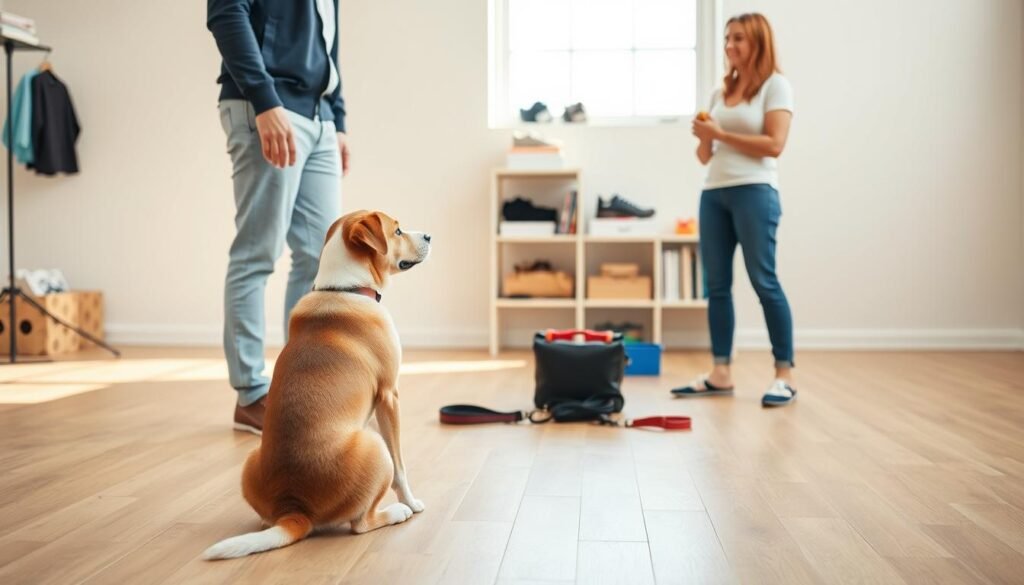
Using the Right Tone and Body Language
How you talk to your dog matters a lot. A positive and upbeat tone makes your dog more likely to listen. But a negative tone can confuse and upset them.
Be consistent in your tone and body language. For instance, a firm but gentle “go potty” lets your dog know it’s time. Also, smiling and open gestures encourage good behavior.
Choosing the Right Location for Outdoor Potty
The spot you pick for your dog’s outdoor potty matters a lot. A good spot can make training easier and more successful.You can learn more about how to stop a dog from barking.
Ideal Spots for Potty Training
Finding the perfect spot for your dog is key. Choose a place that’s easy to get to and near your back door. This helps your dog learn to go there to do their business.
For more tips on training your dog, check out this resource.
Think about the surface and what’s around the area. Some dogs like grass, while others prefer concrete or gravel. Make sure it’s safe and free from things that might distract your dog.
How Scents Can Influence Your Dog
The smell of a spot can really affect your dog’s choice to use it as their outdoor potty. Dogs are attracted to some smells and scared off by others. For example, if it smells like their waste, they might go back. But strong, bad smells can keep them away.
Using positive reinforcement helps a lot. Praise your dog when they use the right spot. The goal is to make a welcoming place for them to go.
Cleaning Up Accidents Effectively
Cleaning up after your dog’s accidents is more than just removing stains. It’s about getting rid of the smell that might bring them back. When your dog has an accident, cleaning the area well is key to stop it from happening again.
Accidents can happen for many reasons, like health issues, anxiety, or not going out in time. No matter the reason, cleaning up right is crucial. Effective cleaning means more than just wiping it clean; it’s about removing the smell that might draw your dog back.
Best Cleaning Products for Eliminating Odors
The right cleaning products are essential for cleaning up after your dog’s accidents. Enzymatic cleaners are top picks because they break down urine proteins, getting rid of the smell.
- Choose products with enzymes that are made to tackle organic stains and smells.
- Stay away from ammonia-based cleaners, as they can draw your dog back with their strong smell.
- Always check the label to make sure the product is safe for your dog and the surface you’re cleaning.
Some top picks for enzymatic cleaners are Nature’s Miracle and Biokleen Bac-Out Stain & Odor Remover. These are great for tackling tough stains and smells, perfect for accidents.
Techniques to Remove Stains
Removing stains needs the right products and techniques. Here’s a simple guide for common stains:
| Stain Type | Cleaning Technique | Product Recommendation |
|---|---|---|
| Urine Stains | Blot the area, apply enzymatic cleaner, let it sit, then rinse and blot dry. | Nature’s Miracle |
| Fecal Stains | Scrape off solid matter, apply enzymatic cleaner, let it sit, then rinse and blot dry. | Biokleen Bac-Out Stain & Odor Remover |
After cleaning, check the area to make sure the stain and smell are gone. If the smell stays, you might need to clean again.
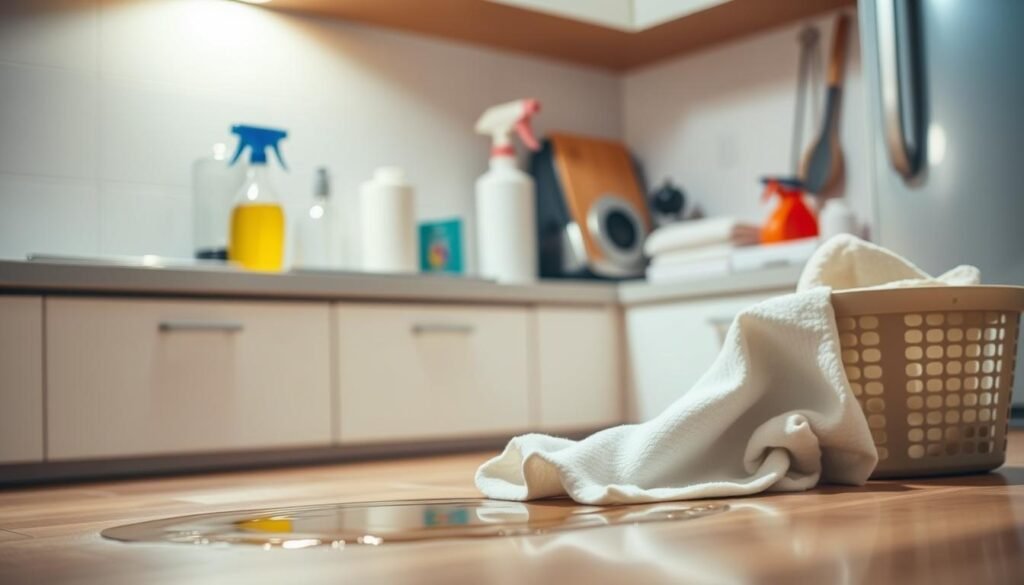
By following these steps and using the right products, you can clean up after your dog’s accidents well. Remember, patience and consistency are key in housebreaking your dog.
Managing Indoor Environment for Success
A well-managed indoor space can greatly reduce indoor peeing accidents. By controlling the environment, you can teach your dog where to go to the bathroom.
Using Crates for Training
Crates are a great tool for potty training. They provide a safe space for your dog and help with housebreaking. This is because they keep your dog in a specific area when you’re not watching.
As certified dog trainer, Karen Pryor, once said, “Crates are not cruel; they’re a way to give your dog a den.” To use a crate well, introduce it slowly and make it a cozy space for your dog.
Limiting Access to Problem Areas
Limiting your dog’s access to areas where they’ve had accidents can prevent more incidents. By doing this, you give your dog fewer chances to make the same mistake.
“Consistency is key when training a dog. Limiting access to certain areas of the house is part of creating a consistent environment that supports potty training.” –
To limit access, use baby gates or pet gates to block off rooms or areas where your dog tends to have accidents. This physical barrier helps reinforce the training by preventing your dog from entering areas where they’re likely to pee.
By combining crate training with limiting access to problem areas, you can create an indoor environment that supports successful potty training. This approach helps your dog understand where it’s okay to go to the bathroom, reducing indoor accidents.
Dealing with Stress and Anxiety in Dogs
Anxiety and stress often lead to dogs peeing inside. Dogs may pee indoors when they’re stressed. Finding out what causes this stress is key to solving the problem.
Identifying Stressful Triggers
Many things can stress out dogs. Changes like moving or new pets can upset them. Knowing what stresses your dog helps them feel safer.
Loud noises and certain objects can also cause stress. Watching how your dog reacts can help spot these triggers.
Ways to Reduce Anxiety
After finding what stresses your dog, you can start to help. Creating a quiet and safe space is a good start. This lets your dog relax away from daily noise.
For more tips on helping dogs with anxiety, check out this resource. It has lots of useful advice.
“A calm environment can significantly reduce a dog’s stress and anxiety levels.”
Techniques like gradual desensitization and positive reinforcement training also work well. Gradual desensitization means slowly getting your dog used to the stressor while rewarding calm behavior.
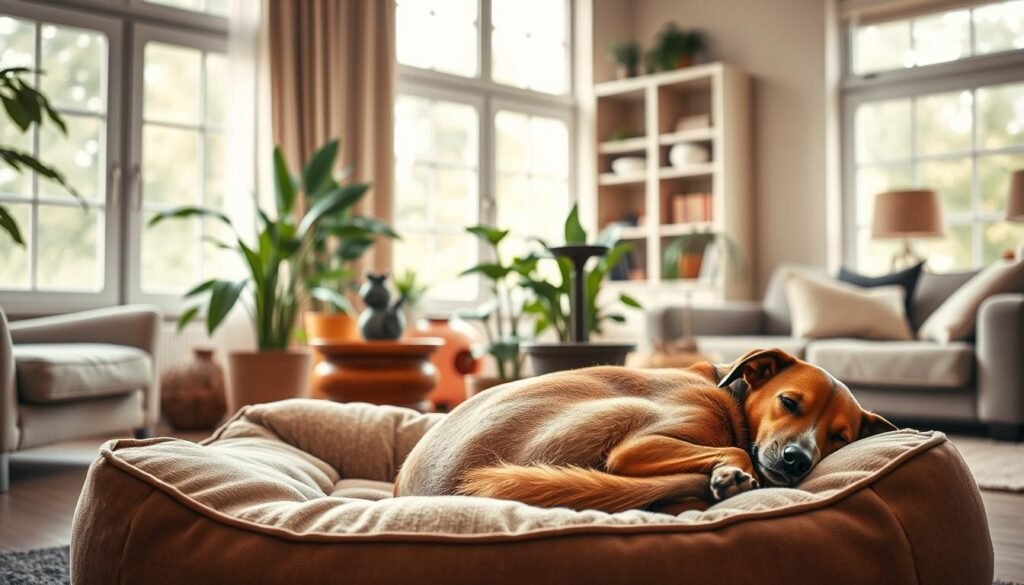
Understanding and tackling your dog’s stress and anxiety can stop indoor peeing. It makes your home a happier place for both you and your pet.
When to Consult a Professional Trainer
Knowing when your dog needs a pro can be key to solving potty training problems. Even with great effort, some issues might not go away. This is when you need a professional trainer.
Signs Your Dog Needs Expert Help
If you see any of these signs, it’s time to get a professional trainer:
- Recurring accidents in the same spot, even after cleaning.
- Steady fear or anxiety about going outside or using the potty.
- Struggling to keep a regular potty schedule.
- Health problems that make potty training hard.
These signs mean your dog might need expert help that fits their needs.
Questions to Ask a Professional
When you talk to a professional trainer, ask the right questions. This ensures you get the best advice. Ask:
- What experience do you have with potty training dogs?
- What methods do you suggest for my dog’s problem?
- How will you help me create a routine that works?
- When can I expect to see improvements?
These questions help you understand how a professional trainer can help you and your dog.
Getting expert help is a smart move to fix potty training problems. With the right advice, you can beat the challenges and succeed in the long run.
Maintaining Patience and Consistency
Potty training a dog needs a lot of patience and consistency. We’ve talked about setting a routine, using positive rewards, and keeping the house clean. But, it’s also key to keep up these efforts to get long-term success.
Overcoming Training Challenges
Dealing with training setbacks is part of the journey. It’s vital to stay calm and not yell or punish the dog for mistakes. This can make them anxious and worsen the problem. Instead, focus on rewarding good behavior and sticking to your training plan.
Fostering a Lasting Outcome
By sticking to the training and keeping a routine, you can help your dog break the habit of peeing inside. With patience and determination, you can achieve a lasting result. This will make your home cleaner and happier for both you and your pet.


